GYPSIES: The Rom



Contents:
Gypsy Wedding of the Year
- The 12-Year-Old Bride
- Europe Protests, But Arranged Weddings Won't Stop
The Rom -- "Gypsies" -- in History
- My Experience With the Gypsies
- The Gypsies and Tarot
- The Gypsy Caravan
- Persecution and Survival
- Gypsy Holidays and Spirituality
The 12-Year Old Bride
September 28, 2003 -- "This is a happy day for the royal household," Florin Cioaba, 39, said before the ceremony. "My youngest daughter is getting married."

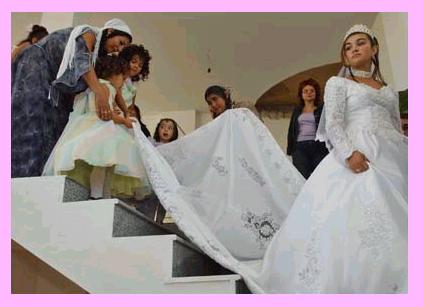

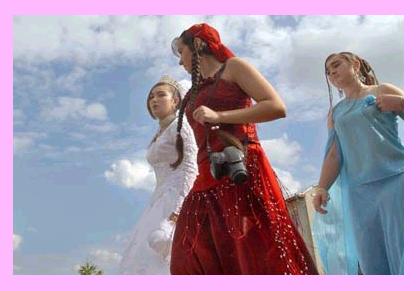



Official figures say more than 550,000 Roma live in Romania, but the real number is believed to be more than 1 million, out of the country's total population of 22 million. Families of Rom have migrated throughout Europe, and some even live in the United States. The Gipsy Kings, fabulous muscians who play an infectious blend of traditional and original compositions, are from a French branch of the Rom family and speak Gitane, a Rom-French dialect.
-- Photos edited from originals and text edited and excerpted from articles by Vadim Ghirda and Alison Mutler for The Associated Press.
October 12, 2003 -- The 12-year-old bride stormed from a church yelling, "Leave me alone!" Though she later returned to be married, her cries are echoing across Europe and sparking a national debate about Romania's tolerance of arranged marriages between Gypsy minors. After pressure from a European Union envoy and human rights activists, Ana Maria Cioaba and her 15-year-old groom, Birita Mihai, are back in their parents' homes and have been told to return to school. But many here say it will take years to end a custom steeped in centuries of Gypsy tradition.
"Even if we acted correctly, what is happening in the Gypsy communities won't change from one year to another, let alone from one day to another," said Emil Boc, a Romanian lawmaker.
Ana Maria's father, Florin Cioaba, who calls himself the "king of all Gypsies," took pains to make his daughter's Sept. 27 wedding a lavish affair in the media spotlight. He donned a golden crown and waved a golden scepter. He invited Gypsy musicians from Austria, ordered a dozen suckling pigs and dressed his youngest daughter in a $4,000 lacy, pearl-encrusted gown from Italy.
The family openly talked about how Ana Maria would stop going to school once she was married. That may have been why, at one point during the ceremony, she stormed out of the church before 400 astonished guests. She tearfully returned a few minutes later and was duly married off, but her bridesmaids shouted "Out with Birita!" during the feast. It was embarrassing for the bride's father, who insists his daughter merely left to use the toilet.
The ensuing uproar over the wedding -- which was never legal because it was only in a church -- prompted Romanian authorities to press for a medical test to determine whether the bride was still a virgin. She has refused. Authorities also ordered the teenage couple separated and all intimate relations between them halted until they are old enough to be legally married. The young groom remains formally under investigation on suspicion of having sex with a minor. If he is charged and convicted, he could be sent to a rehabilitation center.
Though the legal age for marriage in Romania is 18 - 16 if the couple has parental consent -- the country generally tolerates the tradition of arranged child weddings among Roma, as Gypsies also are known. The practice has died out in other parts of Eastern Europe, but continues in neighboring Bulgaria and in Hungary, where nuptials between preteen Gypsies remain "quite common," said Ilan Onodi, a journalist at a radio station that caters to Hungary's Roma.
Romanian commentators have mocked authorities for turning a blind eye to the practice, only to react promptly when the EU envoy to Romania, Baroness Emma Nicholson, protested. Romania hopes to join the EU in 2007. "How much madness, hypocrisy and cowardice can you have in one place?" the influential Evenimentul Zilei said in an editorial. "Who in Romania cared that until now there were Gypsies aged 10-12 getting married?"
Gypsy rights activist Gelu Duminica said no reliable statistics exist for the number of arranged marriages between Gypsy children each year, but estimates run into the dozens. Duminica urged the government to support the integration of Gypsies into Romanian society. Discrimination against them is widespread at a social and professional level. "We need coherent support from the government _ educational programs to explain what the European norms are," he said. According to a recent World Bank study, 80 percent of Gypsies live below the poverty line, and two in three don't have regular employment. Many work on the black market.
Official figures say more than 550,000 Roma live in Romania, but the real number is believed to be more than 1 million. Romania has a population of 22 million. Not all Gypsies arrange marriages between their children, and Gypsy lawmaker Madalin Voicu called the marriage "barbarous." Many Romanians seemed to want to let the tradition continue while making young Gypsy couples wait until they can legally consummate the marriage.
The ancient practice of arranged marriages was deemed necessary to safeguard the ethnic group in the 19th century, when Gypsies were slaves in Romania, Duminica said. To protect the young women from being abused by the local boyars, or noblemen, Gypsies would marry their young women off when they were barely into puberty.
Ana Maria and Birita were engaged five years ago. As is customary, they did not date or spend much time together.
"If it was illegal, why didn't Romanian authorities intervene earlier to stop the wedding?" said Doru Viorel Ursu, the couple's godfather at the wedding.
"They should be allowed to get married in a religious ceremony when they want," said Radu Adrian Pop, a 37-year-old architect. "But they should not consummate the marriage before they are legally allowed to."
-- Edited and excerpted from the article by Alison Mutler, Associated Press Writer, online at Napa News



The Rom -- "Gypsies" -- in History My Experience With the Gypsies
It seemed that a man had rented his storefront on the pretext of opening an office -- but as soon as he had the keys, he moved his entire family into the storefront. The clan apparently included generations of extended relations, and they were all living in a small suite of two rooms which were only zoned to accomodate commercial purposes. There were at least a half a dozen young children, an equal number of teenagers, several middle-aged adults, and some grandparents also, all living without a kitchen and only a small powder room equipped with a toilet and a sink. They had put up some heavy curtains over the storefront windows and refused to let the landlord in to inspect the premises.
He was in an agitated state, since living on the premises was a health problem and against zoning laws. He was also suspicious of where the group were getting their income and what exactly they might be doing to make a living. He identified the people as Gypsies, which surprised me. It never occurred to me that the Rom had clans living in our area, and none of us had never met any before. I had only read about them in books or seen them portrayed in movies or television. The landlord viewed them as a nuisance and saw them as potentially living up to all the negative stereotypes.
Rochester is a city, but a rather small and conservative one. It was against the law to do fortune telling, so there were no crystal ball or palm reading signs in the shop window. Since they rarely seemed to go anywhere, it was difficult to understand where they were getting their income, yet anyone in the clan who appeared old enough to drive had a late-model vehicle. One very young couple, who acted as if they were married, had a brand-new pick up truck. Neither of them even looked old enough to drive, much less to be married. There were many children of both sexes. No one was certain whether the younger children were in school. The lot of them, with the exception of the man who had rented the place, either didn't speak English or wouldn't. With the landlord's complaints and legal problems in getting them evicted, the neighborhood's attitude quickly turned from curiosity to concern.
Our shop, "Woody's," sold snacks and offered a small selection of arcade games. After school let out and it was safe from truant officers to be seen on the street, the Gypsy children would come into the shop en masse. Already skilled in the craft of diversion, some of the children would distract me while others would pilfer bags of chips. One day, they slipped up, and while trying to sneak cookies from a glass jar on the counter, the lid fell on the floor and smashed. The whole group flew out of the store before I even had a chance to respond, and they never came in again.
Soon after, the landlord was successful in getting them evicted, and the whole group disappeared as quickly and enigmatically as they had arrived. I'm certain that all Rom are not thieves or con artists, but unfortunately, the actions of this family reinforced the stereotype of the unscrupulous Gypsy. However, the community was predisposed to be bigoted, uncompassionate, and xenophobic. There seemed to be no breaking through the barrier -- we distrusted them and they distrusted us. The differences in language and culture made it difficult, if not impossible, for them to fit in and make a living honestly in the community. Although they may have been driving new cars, they were living in crowded conditions that made it obvious that money was tight -- even the petty filching by the children was indicative of lack of money for the smallest treats, yet they didn't stay in one place long enough to obtain community services and become more stable.
I wish I had had more time with these unusual people. I hope they found opportunities to become more a part of a community somewhere, but I'm not optimistic that this happened.
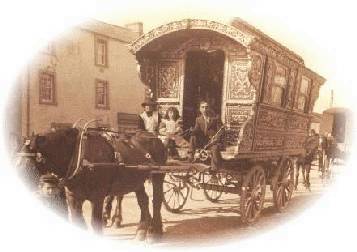
The Gypsy Caravan

Persecution and Survival
"For five hundred years they were slaves in Wallachia and Moldavia (which are now part of Romania) and were liberated only as recently as 1856. Even though their treatment in Eastern Europe was abominable, during that same time period in Western Europe, the flogging, branding, and in some cases hanging of Roma was encouraged. Possibly as many as a million were murdered in the holocaust. Today they live with continued harassment and marginalization in Eastern and Western Europe."
-- Michael Shapiro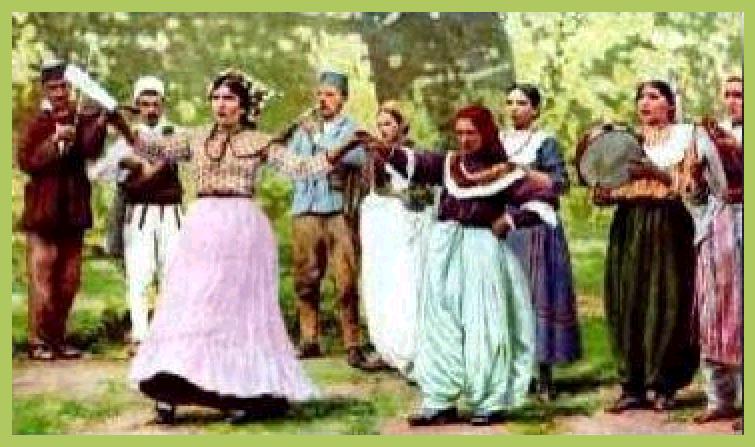
Romani men and women in Slovakia play traditional instruments and dance in this undated photo from Patrin.
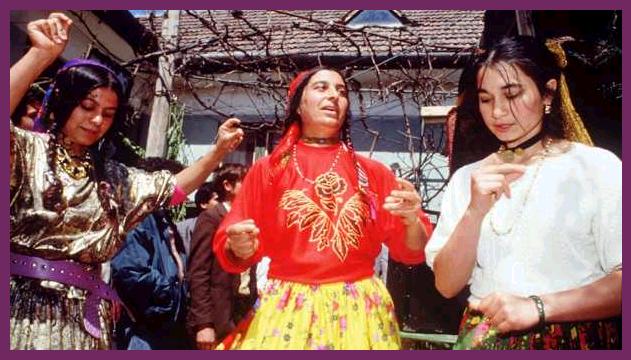
Three Romani women dance and sing in this photo (ca October 2000) by Pierre Perrin for GLMR/Liason Agency.
"It is of course unwise to try to make blanket statements about a people whose diaspora is so widespread, and there are exceptions to every rule; we are talking about people, not modules. Some gypsies do not even answer to the name "Rom." For example, in Spain they are "Caló", in Germany and France they are "Sinto," and in Israel and Egypt they are "Nawar." Today’s globalization will inevitably have an impact on the Roma of the world, whether it be an increasing national pride and political activism or greater assimilation into the gadjé population." -- Michael Shapiro

Gypsy Holidays and Spirituality
Thousands of gypsies make an annual pilgrimage to the village of Les-Saintes-Maries-de-la-Mer in France, honouring their patron Sara and Saints Marie Jacobe and Marie Salome.
“On foot they come. In cars, trucks, and campeurs they come. Tens of thousands of Gypsies flock to the Provençal town of Les-Saintes-Maries-de-la-Mer to keep their annual appointment with a black-faced wooden lady who wears rhinestones and candy-pink satin. Hardly a bigwig on the biblical social register, the woman now known as Saint Sara was the Egyptian servant (so they say) of the Three Maries – Mary Magdalene, Mary Jacob, and Mary Salome (Jesus' aunt). According to legend, they all arrived here in a small boat (along with Saint Lazarus and the Magdalene's sister, Saint Martha) soon after the Crucifixion. While her fellow passengers went on to slay dragons and such, Sara was never noted for any feats at all. And yet....
For some reason, her statue, enshrined here in a pale stone church, is the object of passionate year-round devotion. Rows of votive candles pulsate in the darkness of Sara's crypt. Once in May and again in October, the Gypsies come. They park their vehicles along the seawall. Then, in the crypt, they convene with the statue, commencing a ritual that was long scorned by Catholic officials and finally approved in 1933. The Gypsies fasten layer upon layer of satin raiments around Sara's neck, and then with riotous veneration they carry her down to the beach.”
Rufus, Anneli, The World Holiday Book: Celebrations for every day of the year, HarperSanFrancisco, 1994 (Pip Wilson's Almanac, May 25, 2003)
2nd Sight Publications
2nd Sight Magazine
Body & Soul - Health & Spirituality
* S * H * I * N * Y * New in the Gallery
Cat Tales: Prose, Poetry, Parody, and Punnishment
2nd Sight Index Pages
2nd Sight Groups and Forums Index
News Resource Index
References and Social Issues Index
Path of Life Art Gallery Index
Cat Tales: Literary Page Index


